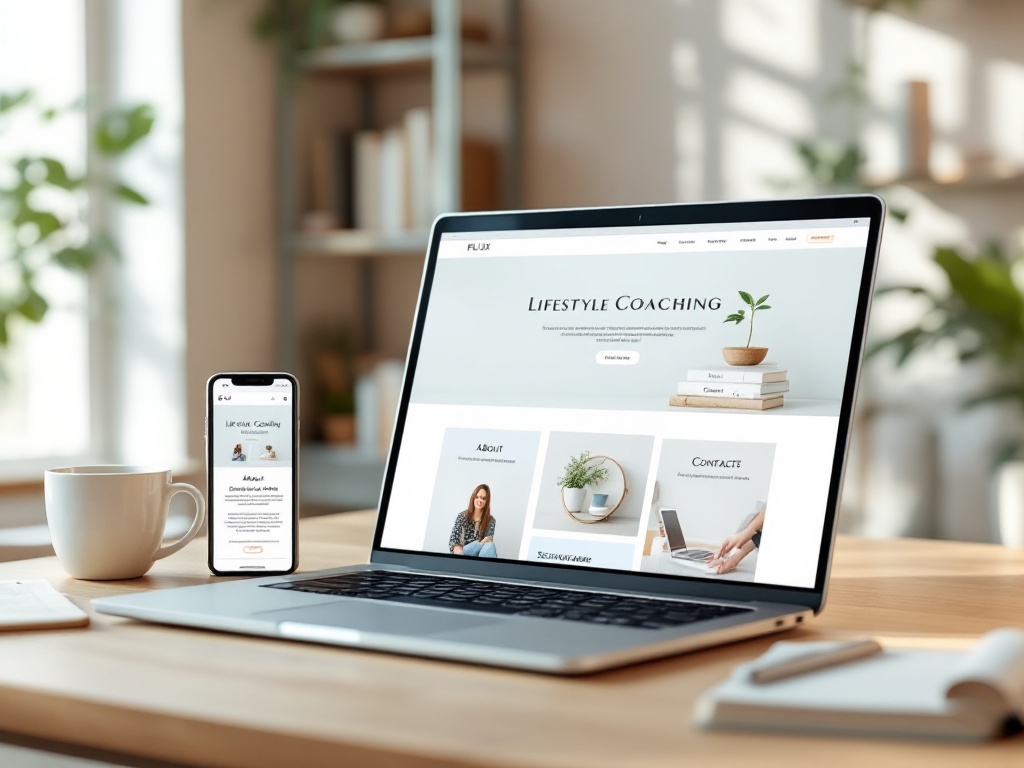Lifestyle coaching thrives on clear communication and a strong online presence. I’ve compiled ten crucial tips for coaches to enhance their practice. These strategies cover everything from crafting an impactful blog to maximizing social media and producing content that captures potential clients’ attention.
Key Takeaways:
- Blogging improves search rankings and showcases your coaching expertise
- Using images and videos in your content dramatically boosts engagement
- Adding quizzes and surveys creates an interactive experience for users
- Developing a community through newsletters and live events strengthens client relationships
- Monitoring metrics and reviewing data is essential to measure blog performance and refine strategies
The Power of Blogging for Lifestyle Coaches
Boosting Your Online Presence
Blogging is a game-changer for lifestyle coaches. It’s a powerful tool that improves your website’s search engine optimization (SEO) and drives more traffic to your site. By consistently producing high-quality content, you’ll position yourself as an expert in your field, attracting potential clients who are searching for guidance.
I’ve found that incorporating images into blog posts is particularly effective. According to industry research, posts with images receive 94% more views than those without. This visual element can significantly enhance engagement and keep readers on your page longer.
Remember to focus on topics that resonate with your target audience, addressing their pain points and offering practical solutions. By doing so, you’ll create a valuable resource that potential clients will return to time and time again, solidifying your reputation as a trusted lifestyle coach.

Starting Your Lifestyle Coaching Blog
Building Your Online Presence
Launching a lifestyle coaching blog is a crucial step in establishing your online presence. I’ll guide you through the process, starting with selecting the right blogging platform. WordPress stands out as a popular choice due to its flexibility and ease of use, but platforms like Squarespace or Wix can also serve you well.
Next, pick a domain name that reflects your brand and is easy to remember. Opt for something catchy yet professional, ideally incorporating your name or coaching niche.
Once you’ve set up your platform and domain, focus on creating essential pages:
- About: Share your story, qualifications, and coaching philosophy
- Services: Detail your coaching packages and offerings
- Contact: Provide multiple ways for potential clients to reach you
Don’t forget the importance of mobile-responsive design. With most web browsing happening on smartphones, ensuring your blog looks great on all devices is non-negotiable. This approach will help you reach a wider audience and create a positive first impression.
By following these steps, you’ll create a solid foundation for your lifestyle coaching blog, setting the stage for successful client interactions and business growth.

Crafting Engaging Content for Your Audience
Showcasing Success and Expertise
I’ve found that sharing success stories and case studies is a powerful way to inspire and motivate clients. These real-life examples demonstrate the tangible results of lifestyle coaching and personal development efforts. To complement these narratives, I regularly include self-improvement tips that readers can immediately apply to their lives.
Expanding Knowledge and Perspectives
Book and resource reviews form an essential part of my content strategy. I carefully select and analyze materials that offer valuable insights into lifestyle coaching and personal growth. Here’s how I structure these reviews:
- Brief summary of the book or resource
- Key takeaways for readers
- How it applies to lifestyle coaching practices
Additionally, I conduct interviews with experts in the field, providing fresh perspectives and cutting-edge strategies. These conversations often uncover innovative approaches to personal development that I can share with my audience. By incorporating diverse voices and experiences, I create a rich tapestry of content that caters to both newcomers and seasoned practitioners in the lifestyle coaching arena.

12 Content Ideas to Attract Clients
Engaging Blog Post Topics for Lifestyle Coaches
I’ve compiled a list of 12 blog post ideas that’ll help you attract and retain clients. These topics blend practical advice, inspiration, and industry insights:
“5 Morning Rituals to Boost Productivity”: Share easy-to-implement habits that can transform readers’ days.
“How to Create a Vision Board That Works”: Guide clients through the process of visualizing their goals.
“The Power of Mindfulness: Simple Techniques for Busy Professionals”: Offer quick mindfulness exercises for stress relief.
“Nutrition Hacks for Better Energy Levels”: Provide actionable tips for improving diet and vitality.
“Overcoming Self-Doubt: A Coach’s Perspective”: Share personal stories and strategies to inspire confidence.
“The Art of Time Management: Balancing Work and Personal Life”: Offer practical scheduling tips for a harmonious lifestyle.
“Fitness for Beginners: Starting Your Journey to Better Health”: Create an approachable guide for newcomers to exercise.
“Navigating Career Transitions: A Step-by-Step Guide”: Help readers manage professional changes effectively.
“The Impact of Social Media on Mental Health”: Discuss digital wellness and offer tips for healthy online habits.
“Financial Wellness 101: Budgeting for Your Dreams”: Provide basic financial planning advice for personal growth.
“Building Meaningful Relationships: Communication Skills for Success”: Share techniques for improving personal and professional connections.
“Self-Care Isn’t Selfish: Why It’s Essential for Success”: Emphasize the importance of personal well-being in achieving goals.

Optimizing Your Blog Posts for SEO
Keyword Research and On-Page Techniques
I’ve found that effective SEO starts with solid keyword research. By identifying relevant terms your audience is searching for, you can craft content that meets their needs and ranks well in search results. Once you’ve chosen your keywords, incorporate them naturally into your post’s title, headings, and throughout the body text.
On-page SEO techniques are crucial for improving your blog’s visibility. Here are key elements to focus on:
- Meta descriptions: Write compelling summaries that include your target keyword
- Alt tags: Add descriptive text to images, helping search engines understand their content
- Header tags: Use H1, H2, and H3 tags to structure your content logically
Internal and external linking also play a vital role in SEO. Link to relevant posts within your site to keep readers engaged and improve site structure. Additionally, include links to authoritative external sources to boost your content’s credibility.
Lastly, maintaining a consistent posting schedule signals to search engines that your site is active and regularly updated. This can positively impact your rankings and attract repeat visitors. By implementing these SEO strategies, you’ll increase your blog’s visibility and attract more potential clients to your lifestyle coaching business.

Leveraging Visual and Interactive Content
Incorporating Visual Elements
I’ve found that images and infographics can significantly boost engagement in lifestyle coaching. They’re perfect for simplifying complex ideas and making information more digestible. To create eye-catching visuals without professional design skills, I use user-friendly tools like Canva or Piktochart. These platforms offer templates and drag-and-drop features that make design a breeze.
Videos are another powerful tool in a coach’s arsenal. They allow for personal connection and can demonstrate techniques more effectively than text alone. I often use my smartphone to record quick tips or explanations, editing them with apps like iMovie or Adobe Premiere Rush.
Adding Interactive Features
Interactive elements can transform passive readers into active participants. Here are some ways I incorporate them:
- Quizzes to help clients assess their progress
- Surveys to gather feedback and tailor services
- Polls to encourage community engagement and spark discussions
These features not only provide value to clients but also offer valuable insights for me as a coach. By analyzing responses, I can refine my coaching strategies and create more targeted content. Remember, the key is to balance visual appeal with meaningful interaction, ensuring that each element serves a purpose in the client’s journey.

Building a Community Through Your Blog
Fostering Engagement and Connection
I’ve found that a thriving blog community starts with encouraging reader interaction. Prompt discussions by ending posts with thought-provoking questions. Respond promptly to comments and feedback, showing readers their input is valued. Create a newsletter to share exclusive content and updates, enticing subscribers to stay connected. Consider hosting regular webinars or live Q&A sessions to directly engage with your audience. These interactive elements allow you to address questions in real-time, building trust and rapport. By implementing these strategies, you’ll create a space where readers feel heard and invested, transforming your blog into a hub of meaningful conversation and shared growth.

Promoting Your Lifestyle Coaching Blog
Effective Promotion Strategies
I’ve found that promoting a lifestyle coaching blog requires a multi-faceted approach. Social media is a powerful tool for sharing content. I recommend crafting engaging posts that tease your blog’s value and encourage clicks. Guest posting on relevant websites can expand your reach and establish credibility. It’s crucial to choose sites that align with your niche and offer valuable content to their audience.
Collaborating with fellow coaches and influencers can create mutually beneficial partnerships, exposing your blog to new readers. Lastly, repurposing blog content for different platforms maximizes its impact. Transform written posts into eye-catching infographics, short videos, or podcast episodes to cater to diverse audience preferences and increase engagement across various channels.

Measuring Your Blog’s Success
Key Metrics and Analysis Tools
I’ve found that tracking specific metrics is crucial for evaluating a blog’s performance. Traffic, engagement, and conversions are the main indicators I focus on. To monitor these, I use tools like Google Analytics for traffic data, social media insights for engagement, and conversion tracking software for sales or sign-ups. These tools provide valuable data that helps me set realistic goals and benchmarks. For instance, I might aim to increase monthly page views by 20% or boost email subscribers by 15% quarter-over-quarter.
By regularly analyzing this data, I can spot trends and adjust my content strategy accordingly. If I notice a particular post type performs well, I’ll create more similar content. Conversely, if certain topics aren’t resonating, I’ll pivot my approach to better serve my audience’s interests.

Converting Blog Readers into Clients
Effective Strategies for Client Conversion
I’ve found that turning blog readers into paying clients requires a mix of persuasion and value-offering. Crafting compelling calls-to-action (CTAs) is crucial. I always ensure my CTAs are clear, action-oriented, and prominently displayed. Offering free resources or consultations can be a game-changer. It gives potential clients a taste of your expertise without any commitment.
Case studies are another powerful tool. They showcase real results and build credibility. I make sure to highlight client success stories regularly. Consistency in delivering valuable content is key to building trust. I aim to provide actionable insights in every post, demonstrating my knowledge and reliability.
By implementing these strategies, I’ve seen a significant increase in client conversions from my blog readership.

Sources:
